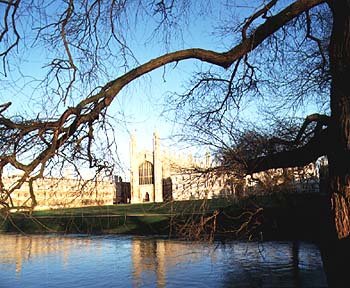
The 'Backs' of the River Cam at Cambridge showing King's College chapel.The Cam is a tributary of the Ouse The River Cam has its source below the scarp face of the Chiltern Hills, starting as a number of small springs where the water table in the Chilterns chalk reaches the surface. From here the headwaters flow over impermeable clay so that no water is lost and there is a high density of streams. Many of these streams meet at Great Shelford, where the Cam also meets the River Granta before meandering through the ancient university city of Cambridge. It is Cambridge that has made the Cam far more famous than its size would suggest, for around the crossing point of this small river grew one of the most famous universities in the world. Here is the famed part of the Cambridge floodplain called 'The Backs'. Too prone to flooding to be built on, the Cambridge colleges that line the banks of the river stay a respectful distance from it and face majestically away, presenting only their backs to the river. The most famous of all Cambridge college buildings, the King's College Chapel, looks over the college lawns and dominates the view over the Backs. The stretch of river between the colleges is also shallow enough for the use of punts and it is here that many students find time for recreation in summer, just as they do at Oxford where the River Cherwell flows into the Thames. Down river of Cambridge, the Cam flows into the vast fenlands of East Anglia. Once an impenetrable area of marshes and a site for reclusive monasteries, the fens were gradually drained and their waters led into the Cam, so that the modern river is much straighter and quite different in shape to that in the past. Just south of Ely, the Cam joins the Ouse on its way to the North Sea at The Wash.
|